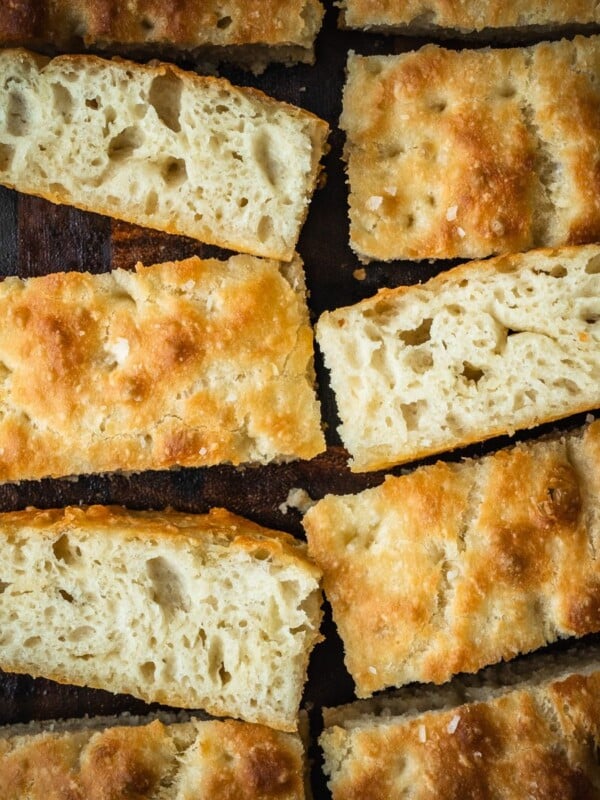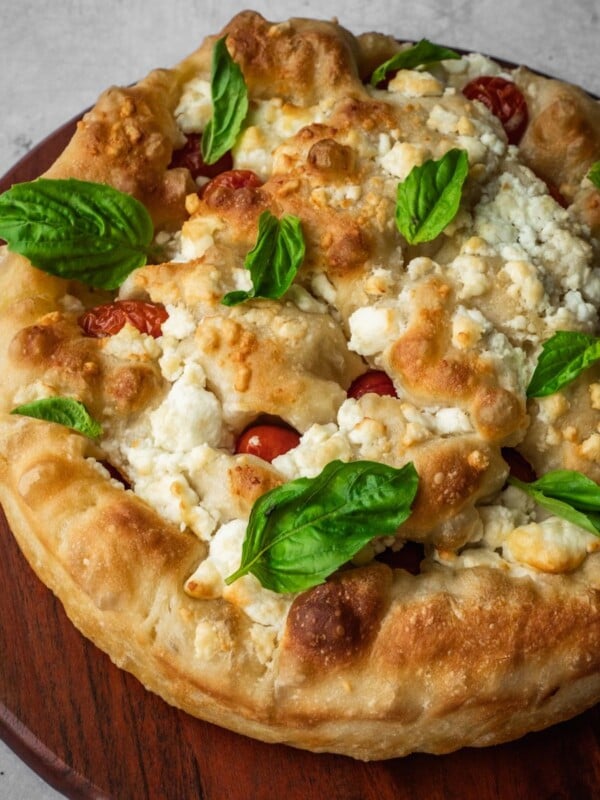Cheese Manakish is a Levantine flatbread topped with a mixture of melty and flavorful cheese and then baked in the oven. A Middle Eastern cuisine staple, it is comforting and incredibly delicious.
It can be eaten on its own or with other Middle Eastern breakfast classics like foul mudammas (fava beans), homemade labneh, homemade hummus, olives, pickled cauliflower, and pickled turnips on the side.

Table of Contents
Depending on the dialect spoken, some folks will also call them Man’ousheh (singular), Mana’eesh (plural), Middle Eastern Pizza, Lebanese Pizza or even Arabic Pizza. Personally, I am not a fan of the “Pizza” label as I think it erases the history of manakish.
There are other variations which include meat (also known as Lahmacun or Lahm b’ajin) and classic zaatar manakish.
It’s a staple breakfast item in Palestine, Lebanon, Syria, Jordan and of course in the diaspora. You can even make a wrap with it by adding fresh vegetables like tomatoes, cucumbers and mint.
The manakish dough used here is based on my master Middle Eastern flatbread recipe.
This master dough recipe has many uses and can be used to make Za’atar Manakish or Lahm b’ajin (Meat Manakish). The master recipe can also be used to make hand pies (cheese fatayer, spinach fatayer and meat-filled fatayer).
Ingredients
This recipe comes together with just a few standard simple ingredients.

- Flour: Depending on your taste and preference, you can play with the all-purpose white flour to whole wheat flour ratio. As long as you maintain the total quantity listed in the recipe you should be just fine. You should also use bread flour if you have it, but AP works just fine.
- Yeast: I use and recommend instant yeast, but you can use active dry yeast (keep the quantity the same) or fresh yeast.
- Milk: The milk helps keep the final product soft and pliable but you can also use water instead of milk.
- Cheese blend: For authenticity, Akawi cheese, a brined cheese from Akka. You can substitute it with feta, but the flavor won’t be quite the same. Akkawi cheese can be found at any Middle Eastern grocery store. These days, you can even find it in international grocery stores as well. Mozzarella cheese is also a must for it’s melty and stretchy properties.
- Nigella seeds: These seeds, also known as Kalonji, aren’t exactly easy to find, but you can totally substitute with black sesame seeds. In fact, I personally prefer this recipe with black sesame seeds!
See the recipe card for full information on ingredients and quantities.
How to Make this Cheese Manakish Recipe
Read through the entire recipe directions first to get your bearings.

Step 1. Mix. In the bowl of a stand mixer, add the dough dry ingredients and mix well to combine. Add the warm water, milk and oil. Run the stand mixer until a ball of dough forms, about 5-7 minutes (Image 1).
Step 2. Rise. Rub the dough ball lightly with oil on all sides and let it rise, covered, in the bowl of the stand mixer for 1 hour in a warm place (Image 2).
Step 3. Cheese Mix. While the dough rises, prepare your cheese mixture in a bowl (Image 3).
Step 4. Divide and shape. After the bread dough has risen to about double its original size, divide it into 6 equal pieces. Shape each piece of dough into a tight ball and rest them on your kitchen counter for 10 minutes, covered, so that the gluten can relax (Image 4).

Step 5. Flatten. Using a rolling pin, flatten the dough balls into discs (Image 5).
Step 6. Dress. Preheat your oven to 425F (220C). Transfer the flat flatbread discs to a parchment paper-lined baking sheet (Image 6a). Divide the cheese mixture equally over the flattened dough (Image 6b). You may need to do this in stages depending on how big your oven is.
Step 7. Bake. Bake in the preheated oven until the edges are lightly golden brown and the cheese mixture is bubbling and browning lightly. Don’t over-bake. We want these flatbreads to be soft and pliable (Image 7).
Expert Tips
- Skip the mixer. You can mix this dough by hand in a large mixing bowl if you don’t have a stand mixer. Make sure to knead it for a full 5 minutes after it comes together on your countertop.
- Pizza Stone. You can bake the flatbreads on a pizza stone or in a pizza oven. You can also gill them, but keep in mind they won’t be as soft and pliable if you grill them directly on the BBQ grates.
- Half and Half. I love a half za’atar, half cheese flatbread. Feel free to adjust the topping to your liking.
- Appetizer size: you can make smaller flatbreads if you wish by dividing the dough into 10 pieces instead of 5 and proceeding with the recipe.

Recipe FAQs
It’s both! The original word is Arabic and when anglicized, regional differences in dialect are reflected in the English spelling. This is quite common with the anglicization of works from languages that don’t use the Latin alphabet.
Baked manakish flatbreads should be stored in a ziplock bag or resealable airtight container so that they can remain soft. Place them in a fridge for up to 5 days.
If you’re looking to save some time, you can make the dough 1 day ahead of time and let it rise in the fridge overnight. This longer, slower rise is actually beneficial in many ways and the result will be a much easier to digest bread for those with gluten sensitives. Just use half the amount of yeast if you plan to let the dough rise in the fridge overnight.
Other Levantine Baked Goods
If you make this Cheese Manakish (Levantine Flatbread) or any other baking recipes on Urban Farm and Kitchen, please take a moment to rate the recipe ⭐⭐⭐⭐⭐ and leave a comment below. It’s such a help to others who want to try the recipe.
For more Urban Farm and Kitchen, follow along on Instagram, Facebook, and Pinterest, visit the Urban Farm Shop, or subscribe for new posts via email.
Cheese Manakish (Middle Eastern Flatbread)

Ingredients
For the Dough
- 2 ¼ cups All purpose flour – 315 grams
- ¾ cups Whole wheat flour – 105 grams
- 1 tbsp Instant yeast – 9 grams
- 1 tbsp White sugar – 12.5 grams
- 1 tsp Kosher salt – 5 grams
- ½ cup Water, warmed – 120 grams
- ½ cup Milk, warmed – 120 grams
- ¼ cup Olive oil – 53 grams
Cheese Topping
- 1 ½ cups Mozzarella, Shredded – 340 grams
- 1 ½ cups Akawi Cheese, Shredded – 340 grams, Substitute with feta
- 1 tsp Nigella Seeds – 3 grams
Instructions
- Mix. In the bowl of a stand mixer, add the dough dry ingredients and mix well to combine. Add the warm water, warm milk and oil. Run the stand mixer until a ball of dough forms, about 5-7 minutes. If the dough is too dry and feels crumbly, add water 1 tablespoon at a time until you have a soft and supple dough ball. You can also mix the dough in a large bowl and knead manually on the countertop.
- Rise. Rub the dough ball lightly with oil on all sides and let it rise, covered with a towel or plastic wrap, in the bowl of the stand mixer for up to 1 hour in a warm place.
- Cheese Mix. While the dough rises, prepare your cheese mixture in a bowl.
- Divide and shape. After the bread dough has risen to about double its original size, divide it into 6 equal pieces. Shape each piece of dough into a tight ball and rest them on your kitchen counter for 10 minutes, covered, so that the gluten can relax.
- Flatten. Using a rolling pin, flatten the dough balls into a ⅛-¼ inch (0.3-0.6cm) thick, about 6-8 inches (15-20cm) in diameter.
- Dress. Preheat your oven to 425F (220C). Transfer the flat flatbread discs to a parchment paper-lined baking sheet. Divide the cheese mixture equally over the flattened dough, leaving a ½ inch border. You may need to do this in stages depending on how big your oven is.
- Bake. Bake in the preheated oven for 9-13 minutes, or until the edges are lightly golden brown and the cheese mixture is bubbling and browning lightly. Don’t over-bake. We want these flatbreads to be soft and pliable. Note: If you peek into the oven mid-bake and you see a big bubble forming, quickly open the oven door, poke it with a fork or knife and close the door back up.
Notes
- Cheese blend: For authenticity, Akawi cheese, a brined cheese from Akka. You can substitute it with feta, but the flavor won’t be quite the same. Akkawi cheese can be found at any Middle Eastern grocery store. These days, you can even find it in international grocery stores as well. Mozzarella cheese is also a must for it’s melty and stretchy properties.
- Nigella seeds: These seeds, also known as Kalonji, aren’t exactly easy to find, but you can totally substitute with black sesame seeds. In fact, I personally prefer this recipe with black sesame seeds!
Nutrition
Nutrition information is automatically calculated, so should only be used as an approximation.
 Like this recipe? Rate & comment below!
Like this recipe? Rate & comment below!














